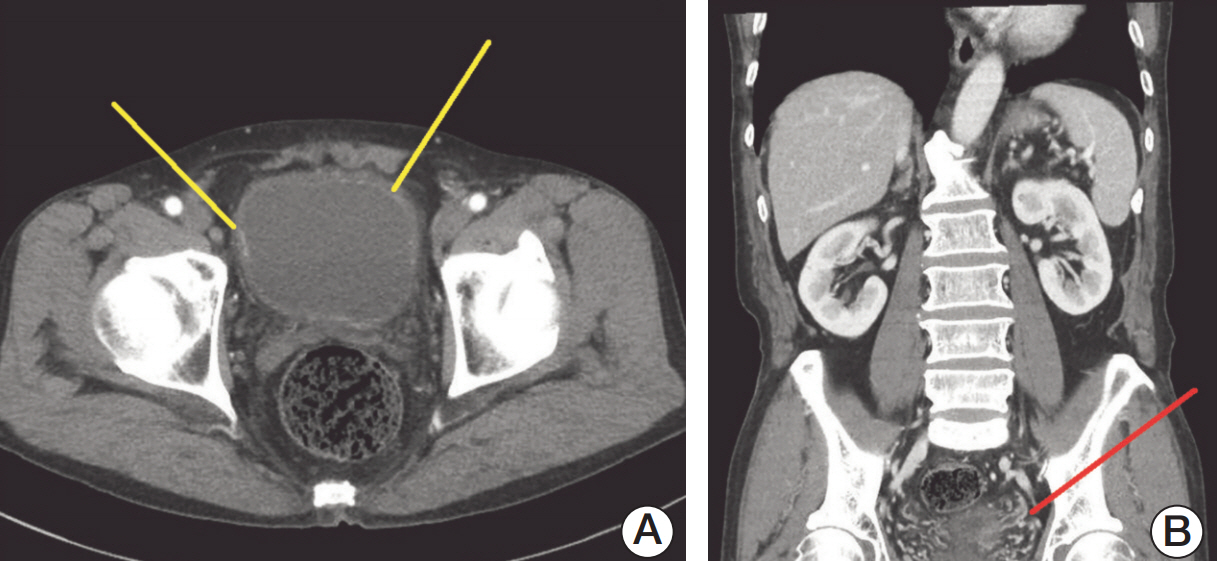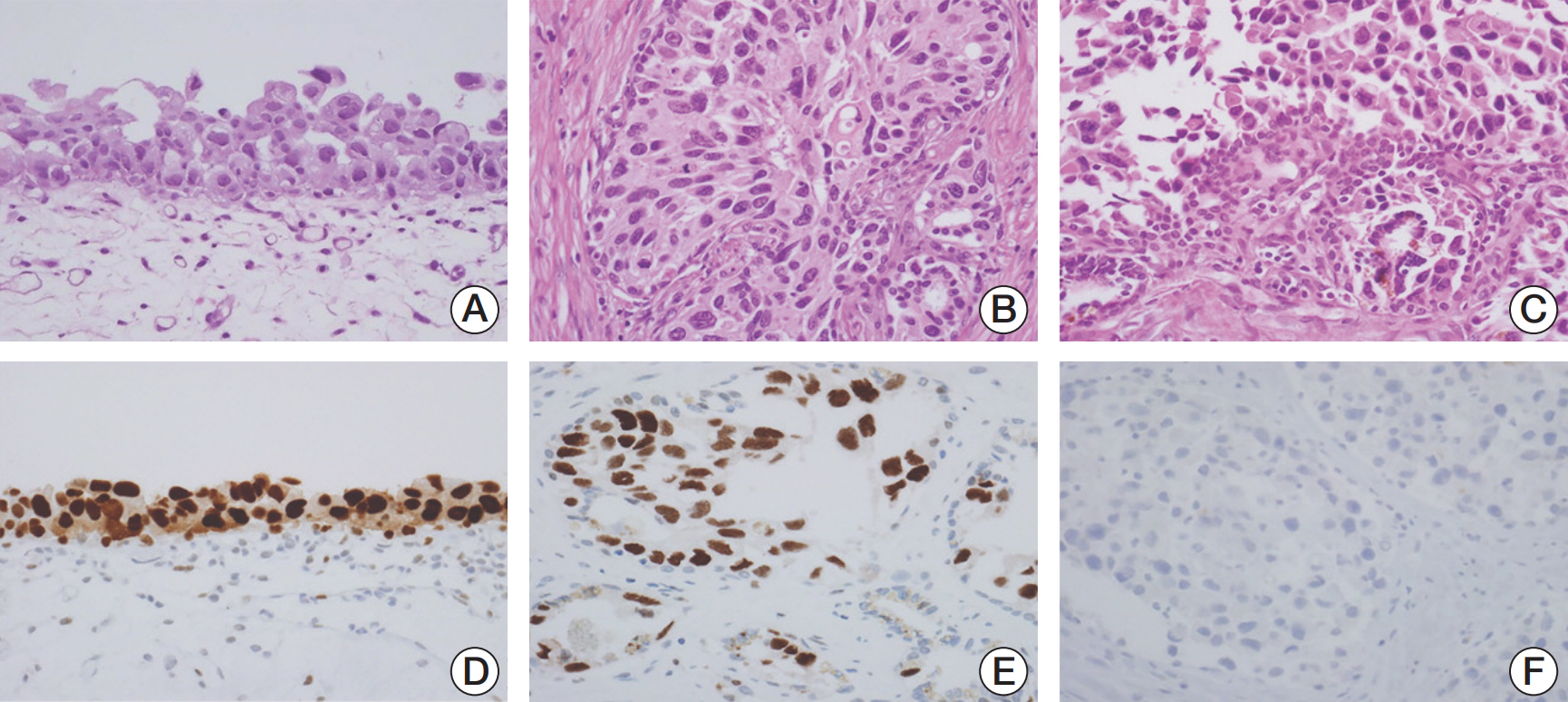Cancer Res Treat.
2020 Oct;52(4):1283-1287. 10.4143/crt.2020.002.
Seminal Vesicle Involvement by Carcinoma In Situ of the Bladder: Clonal Analysis Using Next-Generation Sequencing to Elucidate the Mechanism of Tumor Spread
- Affiliations
-
- 1Department of Urology, Eulji University Hospital, Eulji University School of Medicine, Daejeon, Korea
- 2Department of Microbiology and Immunology, Eulji University School of Medicine, Daejeon, Korea
- 3Department of Pathology, Eulji University School of Medicine, Daejeon, Korea
- 4Personalized Genomic Medicine Research Center, Korea Research Institute of Bioscience & Biotechnology, Daejeon, Korea
- KMID: 2507953
- DOI: http://doi.org/10.4143/crt.2020.002
Abstract
- We present a rare case of urothelial carcinoma in situ (CIS), which invades the prostate and seminal vesicle (SV). A 70-year-old man underwent transurethral resection of bladder (TURB), and the pathologic examination revealed multiple CIS. Although the patient received intravesical bacillus Calmette-Guerin (BCG) therapy following TURB, recurrence of CIS was confirmed in the bladder and left distal ureter at 3 months following BCG. Radical cystectomy was performed due to BCG-refractory CIS. Microscopically, CIS was found throughout the mucosa of the bladder, left ureter, prostatic duct, and both SVs. Next-generation sequencing revealed significant differences in tumor clonality between bladder and SV CIS cells. Among 101 (bladder CIS) and 95 (SV CIS) somatic mutations, only two were shared, and only one gene (ARHGAP23) was common exon coding region gene. In conclusion, multicentric genetic changes, in line with the field-cancerization effect, may result in SV involvement by CIS of the bladder.
Keyword
Figure
Reference
-
References
1. Global Burden of Disease Cancer Collaboration, Fitzmaurice C, Allen C, Barber RM, Barregard L, Bhutta ZA, et al. Global, regional, and national cancer incidence, mortality, years of life lost, years lived with disability, and disability-adjusted life-years for 32 cancer groups, 1990 to 2015: a systematic analysis for the global burden of disease study. JAMA Oncol. 2017; 3:524–48.2. Babjuk M, Bohle A, Burger M, Capoun O, Cohen D, Comperat EM, et al. EAU guidelines on non-muscle-invasive urothelial carcinoma of the bladder: update 2016. Eur Urol. 2017; 71:447–61.
Article3. Daneshmand S, Stein JP, Lesser T, Quek ML, Nichols PW, Miranda G, et al. Prognosis of seminal vesicle involvement by transitional cell carcinoma of the bladder. J Urol. 2004; 172:81–4.
Article4. Volkmer BG, Kufer R, Maier S, Bartsch G Jr, Bach D, Hautmann R, et al. Outcome in patients with seminal vesicle invasion after radical cystectomy. J Urol. 2003; 169:1299–302.
Article5. Montie JE, Wojno K, Klein E, Pearsall C, Levin H. Transitional cell carcinoma in situ of the seminal vesicles: 8 cases with discussion of pathogenesis, and clinical and biological implications. J Urol. 1997; 158:1895–8.
Article6. Ro JY, Ayala AG, el-Naggar A, Wishnow KI. Seminal vesicle involvement by in situ and invasive transitional cell carcinoma of the bladder. Am J Surg Pathol. 1987; 11:951–8.
Article7. Jakse G, Putz A, Hofstadter F. Carcinoma in situ of the bladder extending into the seminal vesicles. J Urol. 1987; 137:44–5.
Article8. Choi SY, Lee HC, Song HG, Kim WJ, Lee OJ. Seminal vesicle involvement by urothelial carcinoma in situ of the bladder with mucosal spread pattern: a case report. Korean J Urol. 2012; 53:368–70.
Article9. Pietzak EJ, Bagrodia A, Cha EK, Drill EN, Iyer G, Isharwal S, et al. Next-generation sequencing of nonmuscle invasive bladder cancer reveals potential biomarkers and rational therapeutic targets. Eur Urol. 2017; 72:952–9.
Article10. Cibulskis K, Lawrence MS, Carter SL, Sivachenko A, Jaffe D, Sougnez C, et al. Sensitive detection of somatic point mutations in impure and heterogeneous cancer samples. Nat Biotechnol. 2013; 31:213–9.
Article11. Kiemeney LA, Witjes JA, Heijbroek RP, Verbeek AL, Debruyne FM. Predictability of recurrent and progressive disease in individual patients with primary superficial bladder cancer. J Urol. 1993; 150:60–4.
Article12. Sidransky D, Frost P, Von Eschenbach A, Oyasu R, Preisinger AC, Vogelstein B. Clonal origin of bladder cancer. N Engl J Med. 1992; 326:737–40.
Article13. Harris AL, Neal DE. Bladder cancer: field versus clonal origin. N Engl J Med. 1992; 326:759–61.14. Habuchi T, Takahashi R, Yamada H, Kakehi Y, Sugiyama T, Yoshida O. Metachronous multifocal development of urothelial cancers by intraluminal seeding. Lancet. 1993; 342:1087–8.
Article15. Jones TD, Wang M, Eble JN, MacLennan GT, Lopez-Beltran A, Zhang S, et al. Molecular evidence supporting field effect in urothelial carcinogenesis. Clin Cancer Res. 2005; 11:6512–9.
Article
- Full Text Links
- Actions
-
Cited
- CITED
-
- Close
- Share
- Similar articles
-
- Seminal Vesicle Involvement by Urothelial Carcinoma in Situ of the Bladder with Mucosal Spread Pattern: A Case Report
- 1 case of seminal vesicle cyst
- Primary Adenocarcinoma of the Seminal Vesicle
- A Case of Seminal Vesicle Cyst
- Successful Treatment of Seminal Vesicle Abscess with Rectal Fistula after Rectal Decompression: Report of a New Case



